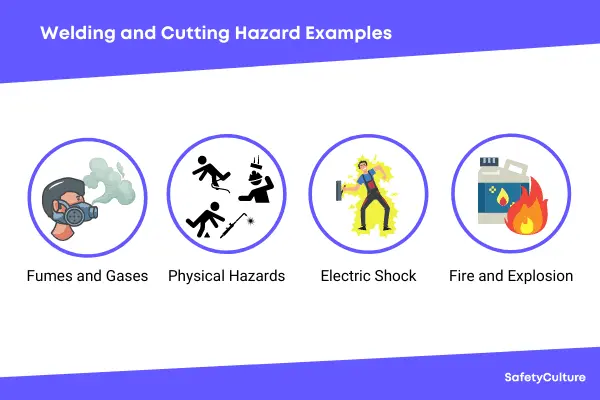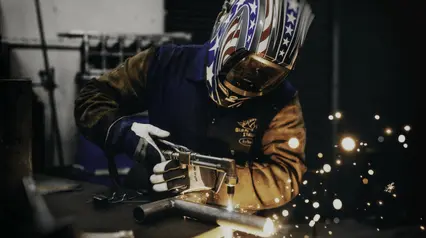Why is Welding Safety Important?
Welding is a hazardous workplace activity which exposes over half a million workers to health and safety risks each year in the United States alone. Welding safety measures are designed to protect employees from welding hazards. Welding safety can be implemented by conducting proper training, inspecting welding equipment, and ensuring workers are aware of safety precautions before performing welding activities to minimize the risk of health and safety injuries.
General Safe Work Practices for Welders
Safety work practices in welding depend on the complexity of the specific task and conditions of the job site, among other factors. Generally, basic welding safety guidelines based on industry standards should be practiced by welders, and these include the following:
- Welding operators should always wear an approved respirator unless exposure assessments are below applicable exposure limits.
- Inspecting welding equipment and electrode holder before proceeding to work.
- Welders should not touch the metal parts of the electrode holder with skin or wet clothing.
- Wearing appropriate PPE like welding helmets and eye protection gear like goggles to protect workers’ eyes and head from hot slag, sparks, intense light, and chemical burns.
- Welding workers should remain in the work area for at least 30 minutes after finishing welding to ensure there are no smoldering fires.
Consider applying the top 10 general welding safety rules in daily business operations.
Improve your EHS Management
Cultivate a safe working environment and streamline compliance with our EHS solutions.
Explore nowWelding and Cutting Hazards Examples

Welding and Cutting Hazard Examples | SafetyCulture
Welding safety involves identifying hazards before proceeding with job tasks in order to remove them, reduce safety risks, and maintain a safe work environment. The 4 most common health and safety hazards of welding include:
Exposure to Fumes and Gases
Overexposure to welding fumes and gases can cause severe health problems like respiratory illnesses, cancer, and impaired speech and movement. Exposure to fumes and gases can be controlled by adhering to these safety precautions.
Physical Hazards
Physical hazards that can cause burns, eye damage, cuts, and crushed toes and fingers are ever-present when welding. With the appropriate Personal Protective Equipment (PPE) and other safety measures, you can protect your workers against physical hazards.
Electric Shock
Electrocution is the most immediate and serious risk for a welder. The sudden discharge of electricity to the human body can cause serious injury and even death. Electrocution risk from welding can be minimized through these basic precautions.
Fire and Explosion
Flammable materials around the working area are the number one cause of a fire. This can be prevented by maintaining a clean working area before proceeding to weld and these other safety controls. It is also important to know the location of fire alarms, emergency exits, and fire extinguishers in the event of a fire.
Create your own Welding Safety Checklist
Build from scratch or choose from our collection of free, ready-to-download, and customizable templates.
Browse Welding Safety ChecklistsPrecautions and Tips
Safety precautions in welding are action steps welders can do to prevent metalworking and welding-related incidents or injuries such as burns, eye injuries, and other skin injuries and even deaths due to explosions, electrocutions, and asphyxiation. In order to eliminate or reduce the most common welding hazards, welders should practice the following safety precautions and tips accordingly:
- Provide adequate ventilation and local exhaust to keep fumes and gases from the breathing zone and the general area.
- Report concerns to a supervisor so your exposure to substances of the welding fumes can be checked.
- Fire and electricity resistant clothing, hand shields, welding gloves, aprons, and boots can be worn to protect workers from heat, fires, electrocution, and burns. Take note that flame retardant treatments become less effective with repeated laundering. Pant legs must not have cuffs and must cover the tops of the boots. Cuffs can collect sparks.
- Earmuffs and earplugs can also protect workers against noise.
- Perform lockout and tag out procedures when performing repairs. Only qualified repair technicians should service or repair welding equipment.
- Keep a suitable Class ABC fire extinguisher nearby while welding. Make sure the extinguisher gauge is full. If an extinguisher is not available, be sure to have access to fire hoses, sand buckets, or other equipment that houses a fire.
- If welding within 35 feet of flammable materials, put a piece of sheet metal or fire-resistant blanket over the flammable material and have a fire watcher nearby to keep track of sparks.
SafetyCulture Marketplace: Your One-Stop Work Gear & Equipment Shop
Improve safety in your workplace with SafetyCulture Marketplace as your one-stop shop for all work gear and equipment needs. Get on-demand access to top quality and specialized work gear from trusted equipment brands in the industry—all in one centralized location. Raise the bar of safety and efficiency by empowering employees to request what they need with just a few taps, anytime and anywhere!
FAQs About Welding Safety
Some of the PPEs required for welding include helmets, gloves, jackets or aprons, boots, HEPA-filtered or supplied-air respirators, hearing protection like earmuffs or earplugs, and safety glasses or goggles. These gears should specifically be appropriate for welding tasks to ensure protection from potential hazards this activity entails.
The Occupational Safety and Health Administration (OSHA) standard for welding safety is 29 CFR 1910.252—which outlines the requirements for welding, cutting, and brazing safety. Some of the key safety measures stated by the standard include providing appropriate PPEs for welders, ensuring proper ventilation to control fumes and gases, and implementing safety procedures for handling and storing welding equipment and materials.
Yes, OSHA does require employers to provide training to welders and other staff who work in occupational categories that are facing a higher risk of exposure to electrical accidents such as industrial machine operators and mechanics. The training should be delivered before an employee is allowed to perform welding operations and repeated as often as needed to make sure that they remain knowledgeable and skilled in safe welding practices
Welding inspections and audits should be performed by qualified and competent personnel that have in-depth knowledge of welding safety requirements, procedures, and standards. Welding inspectors can be from a private company, government agency, third-party auditing firm, or a qualified person identified by the business itself. They should also have enough experience and training to make sure that they are aligned with the current industry best practices.



